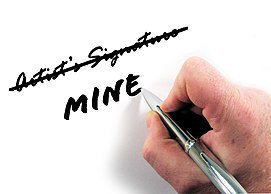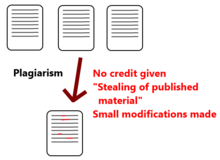Achievement 3 by @ofalamin Task : Content Etiquette
What is Plagiarism?
Plagiarism is the practice of taking someone else's work or ideas and passing them off as one's own.
"Plagiarism is the representation of another author's language, thoughts, ideas, or expressions as one's own original work. In educational contexts, there are differing definitions of plagiarism depending on the institution. Plagiarism is considered a violation of academic integrity and a breach of journalistic ethics. It is subject to sanctions such as penalties, suspension, expulsion from school or work, substantial fines and even incarceration. Recently, cases of "extreme plagiarism" have been identified in academia.
Generally, plagiarism is not in itself a crime, but like counterfeiting fraud can be punished in a court for prejudices caused by copyright infringement, violation of moral rights, or torts. In academia and industry, it is a serious ethical offense. Plagiarism and copyright infringement overlap to a considerable extent, but they are not equivalent concepts, and many types of plagiarism do not constitute copyright infringement, which is defined by copyright law and may be adjudicated by courts." Source
Types of Plagiarism
Complete Plagiarism:
Complete plagiarism is the most severe form of plagiarism where a researcher takes a manuscript or study that someone else created, and submits it under his or her name. It is equivalent to intellectual theft and stealing.
Source-based Plagiarism:
Plagiarism may occur because of the different types of sources. For example, when a researcher references a source that is incorrect or does not exist, it is a misleading citation. Plagiarism also occurs when a researcher uses a secondary source of data or information, but only cites the primary source of information. Both these types lead to an increase in the number of references sources. This, in turn, increases the citation number of the references.
Direct Plagiarism:
Direct or verbatim plagiarism occurs when an author copies the text of another author, word for word, without the use of quotation marks or attribution, thus passing it as his or her own. In that way, it is like complete plagiarism, but it refers to sections (rather than all) of another paper. This type of plagiarism is considered dishonest and it calls for academic disciplinary actions. It is not as common, but it is a serious infraction of academic rules and ethics.
Self or Auto Plagiarism:
Auto-plagiarism, also known as self-plagiarism or duplication, happens when an author reuses significant portions of his or her previously published work without attribution. Thus, this type of plagiarism is most likely to involve published researchers, rather than university students. The severity of this kind of infraction is under debate, depending on the copied content. Many academic journals, however, have strict criteria on the percentage of author’s work that is reusable. Many journals run manuscripts through plagiarism-detection software before considering them for review.
Paraphrasing plagiarism:
This is, as published on Wiley, the most common type of plagiarism. It involves the use of someone else’s writing with some minor changes in the sentences and using it as one’s own. Even if the words differ, the original idea remains the same and plagiarism occurs. Because students often do not have a clear understanding of what constitutes plagiarism, there are recommendations for research and writing available to reduce the risk of paraphrasing plagiarism.
Inaccurate Authorship:
Inaccurate authorship or misleading attribution can happen in two ways:
-In one form, when an individual contributes to a manuscript but does not get credit for it. The second form is the opposite: when an individual gets credit without contributing to the work. This type of plagiarism, whichever way it occurs, is a violation of the code of conduct in research.
-It is also possible to commit this form of plagiarism when someone else edits a manuscript, leading to substantive changes. In this case, the recommendation is to acknowledge the contributors at the time of publication, even if they are not listed as authors.
Mosaic Plagiarism:
Mosaic plagiarism may be more difficult to detect because it interlays someone else’s phrases or text within its own research. It is also known as patchwork plagiarism and it is intentional and dishonest.
Accidental Plagiarism:
Whether intended or unintended, there is no excuse for plagiarism and the consequences are often the same. However, plagiarism may be accidental if it occurred because of neglect, mistake, or unintentional paraphrasing. Students are likely to commit accidental plagiarism, so universities should stress the importance of education about this form of plagiarism.
Consequences of Plagiarism
- Plagiarism can get you expelled from your course, college and/or university.
- Plagiarism can result in your work being destroyed.
- Plagiarism can result in legal action, fines and penalties etc.
Ways to Avoid Plagiarism
- Cite your source
- Include quotations
- Present your own data
- Paraphrase
- Use a plagiarism checker
I have read and understood the Steemit Etiquette on Steemit Community and will do my best to embrace them.


Quickly give brief details on the following;
I have done that, please check again ?
@ofalamin, I am glad you have updated your post as required and hence your post has been verified. You may now proceed to the next achievement task in the series.
Thanks for verification, my next achievement task has been posted
https://steemit.com/hive-172186/@ofalamin/achievement-4-by-ofalamin-task-applying-markdowns